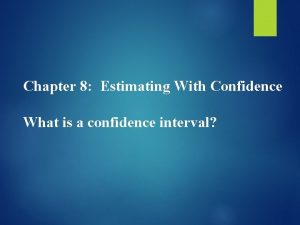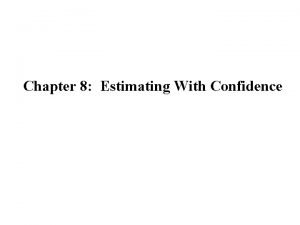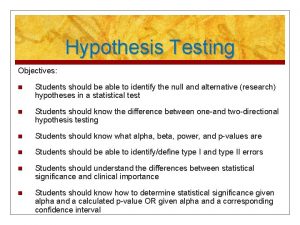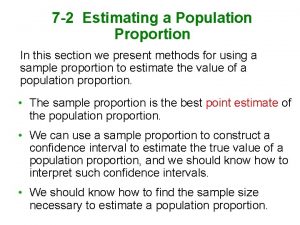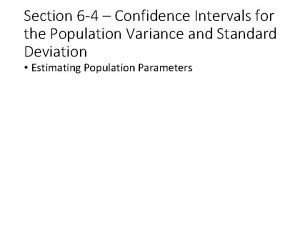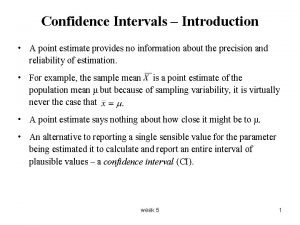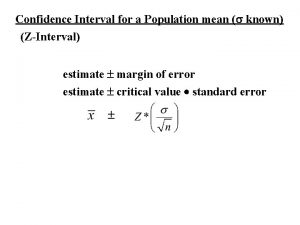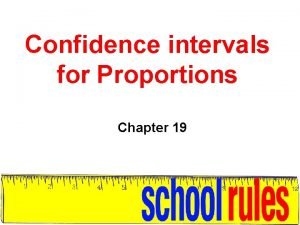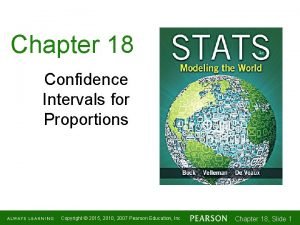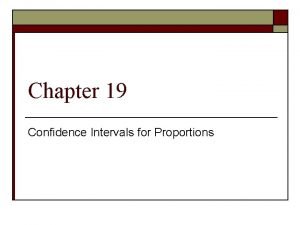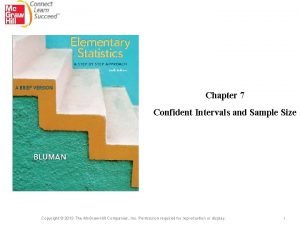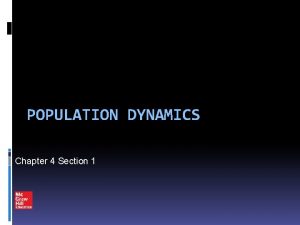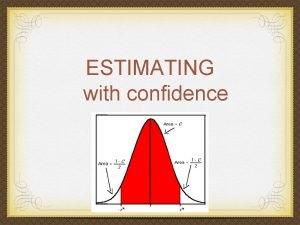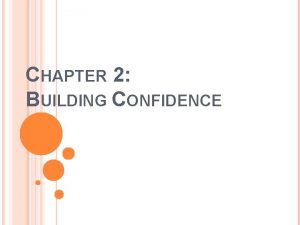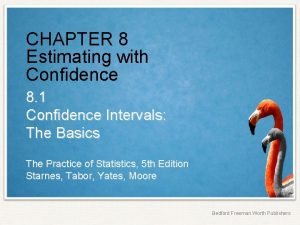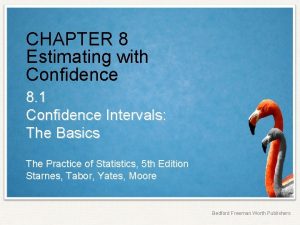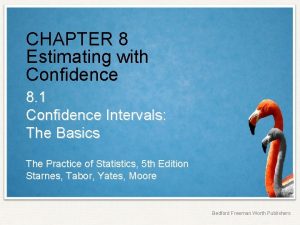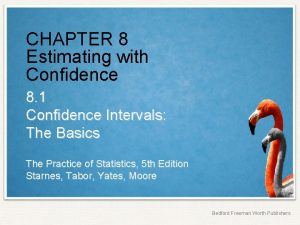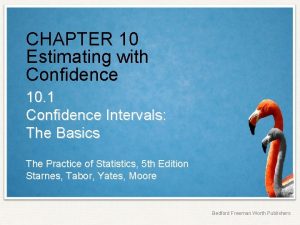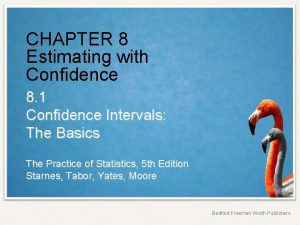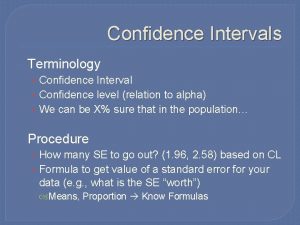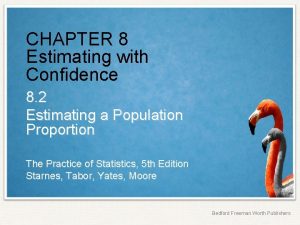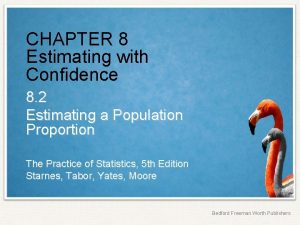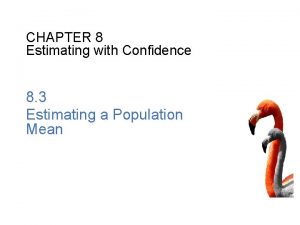Chapter 8 Estimating with Confidence Estimating a Population




















- Slides: 20

+ Chapter 8: Estimating with Confidence Estimating a Population Proportion

The Beads ü Form teams of 3 or 4 students. ü Determine how to use a cup to get a simple random sample of beads from the container. ü Each team is to collect one SRS of beads. ü Determine a point estimate for the unknown population proportion. ü Find a 90% confidence interval for the parameter p. Consider any conditions that are required for the methods you use. ü Compare your results with the other teams in the class. Estimating a Population Proportion Your teacher has a container full of different colored beads. Your goal is to estimate the actual proportion of red beads in the container. + n Activity:

for Estimating p How can we use this information to find a confidence interval for p? Estimating a Population Proportion Suppose one SRS of beads resulted in 107 red beads and 144 beads of another color. The point estimate for the unknown proportion p of red beads in the population would be + n Conditions

for Estimating p Random: The class took an SRS of 251 beads from the container. Normal: Both np and n(1 – p) must be greater than 10. Since we don’t know p, we check that The counts of successes (red beads) and failures (non-red) are both ≥ 10. Independent: Since the class sampled without replacement, they need to check the 10% condition. At least 10(251) = 2510 beads need to be in the population. The teacher reveals there are 3000 beads in the container, so the condition is satisfied. Since all three conditions are met, it is safe to construct a confidence interval. Estimating a Population Proportion Check the conditions for estimating p from our sample. + n Conditions

a Confidence Interval for p Definition: When the standard deviation of a statistic is estimated from data, the results is called the standard error of the statistic. Estimating a Population Proportion We can use the general formula from the previous section to construct a confidence interval for an unknown population proportion p: + n Constructing

a Critical Value If the Normal condition is met, we can use a Normal curve. To find a level C confidence interval, we need to catch the central area C under the standard Normal curve. For example, to find a 95% confidence interval, we use a critical value of 2 based on the 68 -95 -99. 7 rule. Using Table A or a calculator, we can get a more accurate critical value. Note, the critical value z* is actually 1. 96 for a 95% confidence level. Estimating a Population Proportion How do we find the critical value for our confidence interval? + n Finding

a Critical Value + n Finding Since we want to capture the central 80% of the standard Normal distribution, we leave out 20%, or 10% in each tail. Search Table A to find the point z* with area 0. 1 to its left. The closest entry is z = – 1. 28. z . 07 . 08 . 09 – 1. 3 . 0853 . 0838 . 0823 – 1. 2 . 1020 . 1003 . 0985 – 1. 1 . 1210 . 1190 . 1170 So, the critical value z* for an 80% confidence interval is z* = 1. 28. Estimating a Population Proportion Use Table A to find the critical value z* for an 80% confidence interval. Assume that the Normal condition is met.

z Interval for a Population Proportion One-Sample z Interval for a Population Proportion Choose an SRS of size n from a large population that contains an unknown proportion p of successes. An approximate level C confidence interval for p is where z* is the critical value for the standard Normal curve with area C between – z* and z*. Use this interval only when the numbers of successes and failures in the sample are both at least 10 and the population is at least 10 times as large as the sample. Estimating a Population Proportion Once we find the critical value z*, our confidence interval for the population proportion p is + n One-Sample

z Interval for a Population Proportion – 1. 7 . 0418 . 0409 . 0401 – 1. 6 . 0516 . 0505 . 0495 – 1. 5 . 0630 . 0618 . 0606 ü We checked the conditions earlier. ü For a 90% confidence level, z* = 1. 645 statistic ± (critical value) • (standard deviation of the statistic) We are 90% confident that the interval from 0. 375 to 0. 477 captures the actual proportion of red beads in the container. Since this interval gives a range of plausible values for p and since 0. 5 is not contained in the interval, we have reason to doubt the claim. Estimating a Population Proportion Calculate and interpret a 90% confidence interval for the proportion of red beads in the container. Your teacher claims 50% of the beads are red. Use your interval to comment on this claim. z. 03. 04. 05 ü sample proportion = 107/251 = 0. 426 + n One-Sample

Four-Step Process Confidence Intervals: A Four-Step Process State: What parameter do you want to estimate, and at what confidence level? Plan: Identify the appropriate inference method. Check conditions. Do: If the conditions are met, perform calculations. Conclude: Interpret your interval in the context of the problem. Estimating a Population Proportion We can use the familiar four-step process whenever a problem asks us to construct and interpret a confidence interval. + n The

the Sample Size ü z* is the standard Normal critical value for the level of confidence we want. Sample Size for Desired Margin of Error To determine the sample size n that will yield a level C confidence interval for a population proportion p with a maximum margin of error ME, solve the following inequality for n: Estimating a Population Proportion In planning a study, we may want to choose a sample size that allows us to estimate a population proportion within a given margin of error. The margin of error (ME) in the confidence interval for p is + n Choosing

Example A company has received complaints about its customer service. The managers intend to hire a consultant to carry out a survey of the customers. Before contacting the consultant, the company president wants some idea of the sample size that she will be required to pay for. One critical questions is the degree of satisfaction with the company’s customer service, measured on a 5 -point scale. The president wants to estimate the proportion p of customers who are satisfied. She decides that she wants the estimate to be within 3% at a 95% confidence level. How large a sample is needed? + n

Customer Satisfaction ü The critical value for 95% confidence is z* = 1. 96. ü Since the company president wants a margin of error of no more than 0. 03, we need to solve the equation Multiply both sides by square root n and divide both sides by 0. 03. Square both sides. Substitute 0. 5 for the sample proportion to find the largest ME possible. We round up to 1068 respondents to ensure the margin of error is no more than 0. 03 at 95% confidence. Estimating a Population Proportion Read the example on page 493. Determine the sample size needed to estimate p within 0. 03 with 95% confidence. + n Example:

+ n. A Little Bit of Means…

The One-Sample z Interval for a Population Mean Choose an SRS of size n from a population having unknown mean µ and known standard deviation σ. As long as the Normal and Independent conditions are met, a level C confidence interval for µ is The critical value z* is found from the standard Normal distribution. Estimating a Population Mean To calculate a 95% confidence interval for µ , we use the familiar formula: estimate ± (critical value) • (standard deviation of statistic) + n

Example 1 A random sample of 100 students is selected from a certain school. They are given an IQ test which has a known standard deviation of 11. The sample mean is found to be 112. Determine a 98% confidence interval for estimating the mean school intelligence. + n

Example 2 A survey of hospital records of 35 randomly selected patients suffering from a particular disease indicated that the average hospital stay was 10 days with a standard deviation of 2. 1 days. Find a 99% confidence interval and interpret what it means. + n

the Sample Size We determine a sample size for a desired margin of error when estimating a mean in much the same way we did when estimating a proportion. Choosing Sample Size for a Desired Margin of Error When Estimating µ To determine the sample size n that will yield a level C confidence interval for a population mean with a specified margin of error ME: • Get a reasonable value for the population standard deviation σ from an earlier or pilot study. • Find the critical value z* from a standard Normal curve for confidence level C. • Set the expression for the margin of error to be less than or equal to ME and solve for n: Estimating a Population Mean The margin of error ME of the confidence interval for the population mean µ is + n Choosing

How Many Monkeys? + n Example: ü The critical value for 95% confidence is z* = 1. 96. ü We will use σ = 5 as our best guess for the standard deviation. Multiply both sides by square root n and divide both sides by 1. Square both sides. We round up to 97 monkeys to ensure the margin of error is no more than 1 mg/dl at 95% confidence. Estimating a Population Mean Researchers would like to estimate the mean cholesterol level µ of a particular variety of monkey that is often used in laboratory experiments. They would like their estimate to be within 1 milligram per deciliter (mg/dl) of the true value of µ at a 95% confidence level. A previous study involving this variety of monkey suggests that the standard deviation of cholesterol level is about 5 mg/dl.

is Unknown: The t Distributions + n When Estimating a Population Mean When we don’t know σ, we can estimate it using the sample standard deviation sx. What happens when we standardize? This new statistic does not have a Normal distribution!
 Chapter 8 estimating with confidence
Chapter 8 estimating with confidence Chapter 8 estimating with confidence
Chapter 8 estimating with confidence Chapter 8 estimating with confidence
Chapter 8 estimating with confidence Confidence interval vs confidence level
Confidence interval vs confidence level Confidence interval z value
Confidence interval z value Population ecology section 1 population dynamics answer key
Population ecology section 1 population dynamics answer key Chapter 4 section 1 population dynamics study guide
Chapter 4 section 1 population dynamics study guide Estimating a population proportion
Estimating a population proportion Confidence interval for population variance formula
Confidence interval for population variance formula T interval
T interval Confidence interval for population mean
Confidence interval for population mean Zinterval
Zinterval Section 1 population dynamics
Section 1 population dynamics Population ecology section 1 population dynamics
Population ecology section 1 population dynamics Chapter 19 confidence intervals for proportions
Chapter 19 confidence intervals for proportions Chapter 18 confidence intervals for proportions
Chapter 18 confidence intervals for proportions Chapter 19 confidence intervals for proportions
Chapter 19 confidence intervals for proportions When is stage fright most evident
When is stage fright most evident Confidence interval variance formula
Confidence interval variance formula Study guide chapter 4 section 1 population dynamics
Study guide chapter 4 section 1 population dynamics Chapter 53 population ecology
Chapter 53 population ecology
